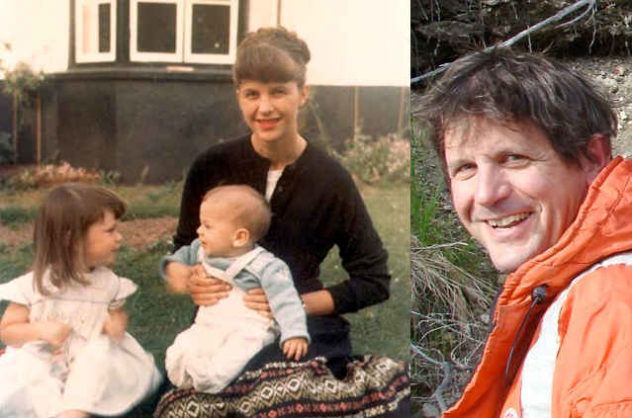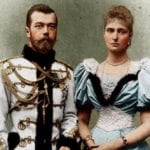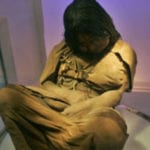Here is a list of ten examples of such people. In some cases, the manner of death has been the same—suicide, drugs, or a medical condition. In other cases, though the manner of death differs, eerie parallels can be seen in the circumstances surrounding the demise of parent and child.
10Bruce Lee and Brandon Lee
Was it a family curse? The Hong Kong-based triads? The Chinese mafia? Rumors swirled in the aftermath of Bruce Lee’s death in 1973. The supremely talented actor and martial artist’s untimely demise at the age of 32, was officially attributed to a brain edema (brain swelling) caused by an allergic reaction to a prescription painkiller, but the conspiracy theories persisted. Many simply could not accept that the invincible, ultra-fit action hero could be neutralized by something so utterly mundane. When his son, Brandon, was killed during filming on the set of the movie The Crow in 1993, the rumors resurfaced with renewed vigor. Though Brandon, aged 28, was killed by a bullet from a gun that was supposed to have been loaded with blanks, the coincidences that surrounded the father and son’s deaths are difficult to ignore. Their lives were tragically short. Both were filming their fifth feature film when they died (Enter the Dragon for Bruce Lee and The Crow for Brandon), and neither saw the release of the films that would catapult them to stardom. However, the most compelling evidence, for those that subscribe to the curse theory, comes from one of Bruce Lee’s other movies. In the movie Game of Death (released posthumously in 1978), Bruce Lee plays an actor. In a pivotal scene, his character is shot during filming when the prop guns are replaced with real ones. Whether coincidence or some mystical, sinister foreshadowing, this iconic scene will continue to taunt fans and conspiracy theorists alike.[1]
9Tim Buckley and Jeff Buckley
Jeff Buckley never liked talking about his father. That is totally understandable. It would be difficult to find much to say about someone you had spent only nine days with. Tim Buckley walked out on his wife and son when Jeff was six months old. When Jeff was eight, he met his father and spent the Easter holidays with him. Nine days.[2] Two months later, Tim Buckley died of a heroin overdose at the age of 28. And though Jeff spent his life trying to sidestep the musical parallels drawn between him and his famous father, he could not avoid a similarly premature end. He died when he was just 30. Two prodigiously talented musicians gone too soon. Both deaths considered accidental. Tim Buckley had been a hard user of drugs in the early days but was not, according to the coroner, an addict at the time of his death. According to his wife, Judy, Tim was “incredibly healthy.” Following an afternoon visit to a friend’s house, Tim suffered an “acute heroin-morphine and ethanol intoxication” that led to his death. His friend, Richard Keeling, was subsequently charged with murder under California law for supplying the drugs that caused Tim’s death. The charge was later downgraded, and Keeling served 120 days jail for involuntary manslaughter. Jeff drowned after an impromptu night swim in Wolf River, a tributary of the Mississippi River, in 1997. A friend watched him swim, fully clothed, for about fifteen minutes before a tugboat appeared. Jeff swam clear, but when a bigger boat followed, he disappeared from sight. His friend, Foti, called for help and a full search was underway within thirty minutes. Jeff’s body was found six days later after a passenger aboard the American Queen spotted something caught in a tangle of bushes floating in the river.
8Whitney Houston and Bobbi Kristina Brown
Both mother and daughter drowned in bathtubs, their bodies riddled with drugs, within three years of each other. Whitney was 48; her daughter, only 21. Some say that Bobbi Kristina did not stand a chance. The daughter of singer celebrities Whitney Houston and Bobby Brown—both well known for their drug use—certainly lacked the modeling of a stable family life. By the time Bobbi Kristina was born in 1993, Whitney’s career was past its peak. She had married Bobby the previous year, and the pair continued to fuel each other’s drug and alcohol addictions. Having a baby to care for proved no incentive for the couple to get clean. A family friend was quoted as saying, “Sometimes Whitney would be so out of it, the baby wouldn’t be changed for days at a time. That’s what drugs will do to you, and it doesn’t matter how rich you are. An addict is an addict.” The blame cannot all be laid at Whitney’s feet though. Bobby was often in trouble with the law, was jealous of his wife’s fame, and relied on her to pay the child support he owed to his exes. After Whitney and Bobby divorced in 2007, mother and daughter formed a closer bond. Whitney might have thought she could moderate Bobbi Kristina’s drug-taking at the parties and nightclubs they attended together, but she was powerless to save her daughter.[3] Unknowingly, Whitney left Bobbi Kristina another toxic legacy. Nick Gordon. While outwardly Bobbi Kristina and Nick’s relationship seemed happy (they let the world believe they had gotten married), things were different behind closed doors. Nick, who had been unofficially adopted by Whitney and had grown up with Bobbi Kristina, was subsequently held “legally responsible” for her death.
7Nancy Benoit and Daniel Benoit
Nancy Benoit and her son Daniel, died at the hand of their husband and father, Chris Benoit, in June 2007. Chris Benoit, a champion wrestler with WWE (World Wrestling Entertainment), strangled his wife and suffocated his son before hanging himself in his gym.[4] And while the evidence for the heinous murder-suicide was clear, the motive was not. Why would a successful professional athlete kill his pro-wrestling wife and young son? Nancy Benoit had had her own career in wrestling, though not in the ring. A former model, Nancy was variously a ringside character, a valet, and a manager. Chris Benoit was her third husband. After the birth of their son, Daniel in February 2000, Nancy began managing her husband’s career from home. A seemingly idyllic life. But three years later, Nancy filed for divorce, saying their relationship was irrevocably broken. In 2004, when Chris Benoit won the Wrestlemania 20 World Heavyweight title, Nancy and Daniel joined him in the ring in celebration. And within another three years, they were all gone. A post-mortem examination concluded that Chris Benoit’s brain was similar to that of an 85-year-old Alzheimer sufferer—possibly due to repeated concussions, or alcohol or steroid abuse. But no one will ever know what motivated his murderous assault. In the years since, the WWE has gone to great lengths to expunge Chris Benoit’s name from the history books, but that will never ease the hearts of the family, friends, and fans of the Benoits.
6Sylvia Plath and Nicholas Hughes
Nicholas Hughes took his own life in 2009, forty-six years after his mother, Sylvia Plath, did the same.[5] Sylvia Plath married fellow poet, Ted Hughes in 1956 after a brief romance. Her first collection of poems, Colossus, was published in 1960, the year the couple’s daughter, Freida was born. Two years later, when their son Nicholas was born, Hughes left Plath for his mistress, Assia Wevill. In early 1963, Plath’s novel The Bell Jar was released, the semi-autobiographical work revealing her long struggle with depression and suicide. The tormented poet, unable to cope with her husband’s infidelity, gassed herself in her London apartment as her children slept. Nicholas Hughes followed a scientific, rather than literary, career. A fisheries scientist with the University of Alaska, he cultivated diverse hobbies including pottery, woodworking, boating, cycling, gardening, and cooking the perfect pecan pie. Two years prior to his death, Nicholas gave up his professorship to focus on his pottery. Despite his devotion to this therapeutic pastime, he lost his battle with depression. It was his sister, Freida, who announced his death, by hanging, to the world. The tragedy of Nicholas Hughes is that he endured not one maternal suicide, but two. His father’s mistress, Assia Wevill, moved in with the family after Sylvia’s death, filling in as mother, until she too committed suicide.
5Assia Wevill and Shura Wevill
Assia Wevill was on her third marriage when she met Ted Hughes in May 1962. Their torrid affair commenced within weeks, and by the end of September, when the couple were no longer hiding their relationship, Sylvia Plath kicked her husband out. Within days of Sylvia’s death in the following February, Assia separated from her husband and moved into the Hughes family flat. Later that year, Assia returned to her husband but continued her affair with Ted. She gave birth to her daughter, Shura, in March 1965 and then made the permanent split from her husband ten months later. Assia joined Ted and his children in Ireland. Their stay in Ireland was brief though. When Ted’s mother fell ill, the family returned to Devon to care for her. Assia was ignored by Ted’s parents, who strongly disapproved of their scandalous relationship. To keep the peace, Assia and Shura returned to London. Assia used her time to look for a new house for the family, but when Ted did not approve of any of them, she came to realize that he had no intention of marrying her. Assia spiraled into despair at this realization and planned to take her own life. But what of her daughter? Imagining a bleak future for the now four-year-old as either a second-class citizen in the Hughes house, or worse, being adopted out as an orphan, Assia made her decision. “Execute yourself and your little self efficiently,”[6] she wrote in her diary, days before her death. In March 1969, Assia carried her sleeping daughter to the kitchen, turned on the oven’s gas taps and then lay down on the floor beside Shura.
4Romanov Family
Much has been written about the execution of the exiled Russian royal family in 1918. The former Tsar Nicholas II and Tsarina Alexandra, along with their five children, suffered gruesome deaths. When the reviled Tsar Nicholas II was forced to abdicate the throne in February 1917, he and his family were sequestered in Alexander Palace, not far from Petrograd. But as calls grew for the ex-tsar to face a public trial for his shambolic rule, the family was shunted to Siberia for their protection. In April 1918, they were moved again, this time closer to Moscow. The family was initially separated due to the illness of their hemophiliac son, Alexei, who arrived three weeks later, traveling with three of his sisters. On the terrifying train journey, the sisters were molested, but eventually, the family was reunited in dingy quarters in Ekaterinburg. In July 1918, with the fall of Ekaterinburg imminent, Yakov Yurovsky, the new commandant of the House of Special Purpose, sought approval for the execution of the Romanov family. Once approval was obtained, he recruited a squad to murder the royals before burning and burying their remains in the woods. An elite squad of soldiers would have made short work of the royals and their entourage, but it was not an elite squad that was sent. When the shooting began, most soldiers concentrated fire on the parents—balking at shooting the children. But what the soldiers did not know, was that the royals had sewn their fortune—mostly diamonds—into their clothes for safekeeping, effectively making their clothing bulletproof. After the first volley of bullets, the royal couple was dead but the children, along with several soldiers, were wounded but alive. Through a pall of dust and smoke, the soldiers waded through blood to silence the screams of the wounded. Some were stabbed with bayonets; others were shot in the head. The chaotic slaughter went on for twenty minutes. The Romanovs’ bodies were taken to the woods, doused in sulphuric acid, burned with gasoline, and then buried.[7] A violent end to a privileged life for parents and children alike.
3Carlo Buonaparte and Napoleon Bonaparte
Carlo Buonaparte, father of Napoleon Bonaparte, died of stomach cancer in 1795, while Napoleon was studying at the military academy in Paris. For all Napoleon’s military prowess, France’s former emperor could not conquer the enemy that lurked within his own body. When he abdicated in 1815, the British government banished him to St Helena island, and within two years his health had begun to deteriorate. Prior to his death in 1821, he had lost 10-15 kilograms (22 to 33 pounds) and suffered abdominal pains and profuse sweating. He was vomiting blood, and his complexion had become very pale. An autopsy performed at the time concluded that he had died of stomach cancer. Modern scientists have confirmed that Napoleon did indeed die of stomach cancer, but not an inherited form.[8] The ulcerated lesions, referred to in the original autopsy report, suggest that he was chronically infected with the Helicobacter pylori bacteria. Scientists consider this bacteria, rather than an inherited genetic factor, to be the cause of Napoleon’s stomach tumors.
2Malin Matsdotter and Daughter
Swedish widow Malin Matsdotter was burned at the stake in 1676 after being accused by her daughters of taking their children—Malin’s grandchildren—to satanic masses. Unlike most people found guilty of witchcraft in Swedish history, Malin Matsdotter was burned alive. Usually, convicted witches were decapitated or hanged prior to burning. So what made Malin different? She refused to admit her guilt.[9] At the stake, one of Malin’s daughters called out to her from the audience to confess her crimes to save her soul. Malin refused. Instead she “gave her daughter into the hands of the devil and cursed her for eternity.” It is reported that Malin showed no pain as the flames consumed her, and she died silently. To those that bore witness, this was further proof of her guilt—the accepted wisdom at that time being that witches felt no pain. Soon after, when the appetite for witch trials waned, attention turned to the false accusers. One of Malin’s daughters was found guilty of perjury and subsequently executed.
1Lady Jane Grey and Henry Grey
Lady Jane Grey was the Nine Days Queen.[10] She was executed when she was just sixteen. Rather than the child following in a parent’s footsteps, Henry Grey followed his daughter to the block in 1554. With the decline in young King Edward’s health in 1553, his advisor, John Dudley, Duke of Northumberland, acted to protect his position of power in the court. If either of Edward’s sisters took the throne, he would be out of a job. Dudley convinced Edward to declare Mary and Elizabeth illegitimate and pass the crown to Jane Grey, who was married to his fourth son, Lord Guilford Dudley. King Edward died on July 6; Lady Jane Grey was crowned Queen three days later. But John Dudley had underestimated Lady Mary’s support, as well as overestimating his own. Lady Mary was popular, and she amassed a sizeable army. When Mary arrived at the Tower, and Dudley’s supporters deserted him, Lady Jane was relieved of her crown—after only nine days. Delighted to hand the crown to Mary, the naïve Lady Jane asked when she could go home. But there was no going home. She was imprisoned in the Tower of London. John Dudley was executed three weeks later for his acts of treason. Lady Jane and her husband remained in prison until Henry Grey attempted to join Thomas Wyatt’s rebellion in January 1554. His actions sealed her fate. While Lady Jane lived, she was a threat to the Queen. Lady Jane Grey was executed, along with her husband, on 12 February 1554. Henry Grey followed eleven days later. Sarah Fisher is an author of young adult fantasy fiction. Follow her on Twitter @WhatTheFish9
























